- Clone
- NKI-M9 (See other available formats)
- Regulatory Status
- RUO
- Workshop
- IV 103
- Other Names
- Vitronectin receptor α chain, Integrin αV, αV integrin, ITGAV
- Isotype
- Mouse IgG2a, κ
- Ave. Rating
- Submit a Review
- Product Citations
- publications
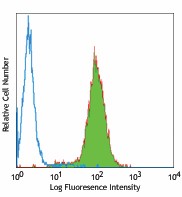
-

Human melanoma cell line M21 stained with Ultra-LEAF™ purified NKI-M9, followed by anti-mouse IgG FITC -

MDA-MB231 breast cancer cell line was stained with anti-human CD51, detected with anti-mouse DyLight™ 649, and nuclear counterstained with DAPI. Images were acquired with a TE300 fluorescence microscope with a 20x objective. Data provided by: Er Liu and John Nolan, La Jolla Bioengineering Institute
| Cat # | Size | Price | Quantity Check Availability | Save | ||
|---|---|---|---|---|---|---|
| 327911 | 100 µg | 216€ | ||||
| 327912 | 1 mg | 542€ | ||||
Select size of product is eligible for a 40% discount! Promotion valid until September 30, 2024. Exclusions apply. To view full promotion terms and conditions or to contact your local BioLegend representative to receive a quote, visit our webpage.
CD51 is a type I integral membrane glycoprotein, known as vitronectin receptor α chain, or integrin αV. It forms heterodimer with integrin β1 (CD29), β3 (CD61), β5, β6, or β8. CD51 contains two disulfide-linked subunits of 125 kD and 24 kD, and is expressed on endothelial cells, fibroblasts, macrophages, platelets, osteoclasts, neuroblastoma, melanoma, and hepatoma cells. Many extracellular matrix proteins with RGD-motifs are CD51 ligands. In association with its β chains, CD51 binds vitronectin, von Willebrand factor, fibronectin, thrombospondin, osteopontin, fibrinogen, and laminin. CD51, as an adhesion molecule, plays important roles in leukocytes homing and rolling, mediates bone absorption and angiogenesis.
Product DetailsProduct Details
- Verified Reactivity
- Human
- Antibody Type
- Monoclonal
- Host Species
- Mouse
- Immunogen
- Melonama cells
- Formulation
- 0.2 µm filtered in phosphate-buffered solution, pH 7.2, containing no preservative.
- Endotoxin Level
- Less than 0.01 EU/µg of the protein (< 0.001 ng/µg of the protein) as determined by the LAL test.
- Preparation
- The Ultra-LEAF™ (Low Endotoxin, Azide-Free) antibody was purified by affinity chromatography.
- Concentration
- The antibody is bottled at the concentration indicated on the vial, typically between 2 mg/mL and 3 mg/mL. Older lots may have also been bottled at 1 mg/mL. To obtain lot-specific concentration and expiration, please enter the lot number in our Certificate of Analysis online tool.
- Storage & Handling
- The antibody solution should be stored undiluted between 2°C and 8°C. This Ultra-LEAF™ solution contains no preservative; handle under aseptic conditions.
- Application
-
FC - Quality tested
ICC - Verified
ELISA, Block, IP - Reported in the literature, not verified in house - Recommended Usage
-
Each lot of this antibody is quality control tested by immunofluorescent staining with flow cytometric analysis. For flow cytometric staining, the suggested use of this reagent is ≤ 2.0 µg per million cells in 100 µL volume. It is recommended that the reagent be titrated for optimal performance for each application.
-
Application References
(PubMed link indicates BioLegend citation) -
- Knapp W, et al. Eds. 1989. Leucocyte Typing IV. Oxford University Press. New York.
- Defilippi P, et al. 1991. J. Cell Biol. 114:855. PubMed
- Burdick MM, et al. 2003. Am. J. Physiol.Cell Ph. 284:C977. PubMed
- Grzeszkiewicz TM, et al. 2001. J. Biol. Chem. 276:21943.
- Sonnenberg A, et al. 1990. J. Cell Biol. 110:2145. PubMed
- Silverman AP, et al. 2008. J Mol Biol. 385:1064. PubMed
- Khurana S, et al. 2013. Blood. 121:2587. PubMed
- RRID
-
AB_2832640 (BioLegend Cat. No. 327911)
AB_2832641 (BioLegend Cat. No. 327912)
Antigen Details
- Structure
- Integrin, forms heterodimer with integrin β1 (CD29), β3 (CD61), β5, β6, or β8, 125 kD and 24 kD in reduced condition, 150 kD (unreduced)
- Distribution
-
Endothelial cells, fibroblasts, macrophages, platelets, osteoclasts, neuroblastoma, melanoma, and hepatoma cells.
- Function
- Adhesion, angiogenesis
- Ligand/Receptor
- Vitronectin, von Willebrand factor, fibrinogen, thrombospondin, osteopontin, denatured collagen, fibronectin, laminin.
- Cell Type
- Endothelial cells, Fibroblasts, Macrophages, Mesenchymal Stem Cells, Osteoclasts, Platelets
- Biology Area
- Angiogenesis, Cell Adhesion, Cell Biology, Costimulatory Molecules, Immunology, Stem Cells
- Molecular Family
- CD Molecules
- Antigen References
-
1. Nesbitt S, et al. 1993. J. Biol. Chem. 268:16737.
2. Zola H, et al. 2007. Leukocyte and Stromal Cell Molecules:The CD Markers Wiley-Liss A John Wiley & Sons Inc, Publication - Gene ID
- 3685 View all products for this Gene ID
- UniProt
- View information about CD51 on UniProt.org
Related Pages & Pathways
Pages
Related FAQs
- Do you guarantee that your antibodies are totally pathogen free?
-
BioLegend does not test for pathogens in-house aside from the GoInVivo™ product line. However, upon request, this can be tested on a custom basis with an outside, independent laboratory.
- Does BioLegend test each Ultra-LEAF™ antibody by functional assay?
-
No, BioLegend does not test Ultra-LEAF™ antibodies by functional assays unless otherwise indicated. Due to the possible complexities and variations of uses of biofunctional antibodies in different assays and because of the large product portfolio, BioLegend does not currently perform functional assays as a routine QC for the antibodies. However, we do provide references in which the antibodies were used for functional assays and we do perform QC to verify the specificity and quality of the antibody based on our strict specification criteria.
- Does BioLegend test each Ultra-LEAF™ antibody for potential pathogens?
-
No, BioLegend does not test for pathogens in-house unless otherwise indicated. However, we can recommend an outside vendor to perform this testing as needed.
- Have you tested this Ultra-LEAF™ antibody for in vivo or in vitro applications?
-
We don't test our antibodies for in vivo or in vitro applications unless otherwise indicated. Depending on the product, the TDS may describe literature supporting usage of a particular product for bioassay. It may be best to further consult the literature to find clone specific information.
Other Formats
View All CD51 Reagents Request Custom Conjugation| Description | Clone | Applications |
|---|---|---|
| Purified anti-human CD51 | NKI-M9 | FC,ICC,ELISA,Block,IP |
| Biotin anti-human CD51 | NKI-M9 | FC |
| FITC anti-human CD51 | NKI-M9 | FC |
| PE anti-human CD51 | NKI-M9 | FC |
| Ultra-LEAF™ Purified anti-human CD51 | NKI-M9 | FC,ICC,ELISA,Block,IP |
| APC anti-human CD51 | NKI-M9 | FC |
| PE/Cyanine7 anti-human CD51 | NKI-M9 | FC |
Compare Data Across All Formats
This data display is provided for general comparisons between formats.
Your actual data may vary due to variations in samples, target cells, instruments and their settings, staining conditions, and other factors.
If you need assistance with selecting the best format contact our expert technical support team.
-
Purified anti-human CD51
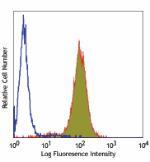
Human melanoma cell line M21 stained with purified NKI-M9, f... 
MDA-MB231 breast cancer cell line was stained with anti-huma... -
Biotin anti-human CD51
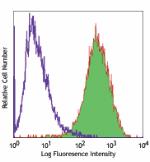
Human melanoma cell line M21 stained with biotinylated NKI-M... -
FITC anti-human CD51

Human melanoma cell line M21 stained with NKI-M9 FITC -
PE anti-human CD51
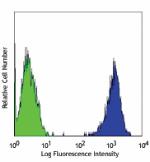
Human melanoma cell line M21 stained with NKI-M9 PE -
Ultra-LEAF™ Purified anti-human CD51

Human melanoma cell line M21 stained with Ultra-LEAF™ purifi... 
MDA-MB231 breast cancer cell line was stained with anti-huma... -
APC anti-human CD51
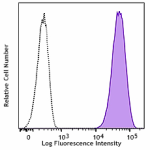
Human melanoma cell line M21 was stained with CD51 (clone NK... -
PE/Cyanine7 anti-human CD51
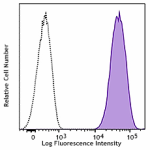
Human melanoma cell line M21 was stained with CD51 (clone NK...
 Login / Register
Login / Register 










Follow Us